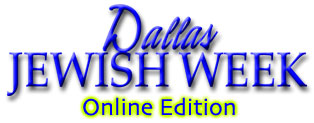|
Dallas Jewish Week Menu
|
 |
'Cutting'-edge artist exhibits in Dallas
18th-century technique being revived by Jerusalem native
by Clive Jonas
Special to DJW
As part of this Sunday's Yom Ha'atsma'ut - Israel Independence Day - festivities at the Aaron Family Jewish Community Center, Israeli artist, educator and scholar Gad Friman will be on hand to exhibit his artwork and speak about Israel from an insider's point of view.
Called "A Touch of Jerusalem," Friman's artwork will be on display from 12 to 4 p.m. at the Center's Senior Lounge, with a talk by the artist scheduled at 2 p.m.
Friman, a ninth-generation Jerusalemite, will have a number of his intricate and elaborate papercuts on display, some of which have never been shown or offered for purchase outside of Israel.
Papercuts have been a form of Jewish traditional art from at least the 18th century. Ketubot, marriage certificates, Sukkah decorations and amulets were just a few ways in which this art form was used. During the early 20th century, the art of papercutting declined and after the Holocaust it all but disappeared. Friman is one of the artists reviving this lost traditional art form. In the artist's work, there are numerous sketches and drawings associated with Jewish Festivals, the Twelve Tribes and other central Jewish themes.
Friman has showed his work at exhibitions in New York, Winnipeg, Toronto, and Israel. His most recent showing at the Haifa Museum's International Papercut Exhibition was received with much acclaim.
Friman said that papercutting was one of the few forms of art work that yeshiva students were traditionally able to practice.
At a young age, Friman's artistic aptitude was evident, and although he never received any formal training, apart from silk and stone printing, he began to experiment in many different mediums and forms. However, he admits that there were not very many artistic outlets in the Jerusalem of his boyhood.
Describing himself as "both a Jewish and humanistic artist," Friman has a broad portfolio that includes modern and abstract works, in forms ranging from oils, sculptures, and papercuts.
In fact, it was not until the mid-1970s, while Friman was in Winnipeg teaching at a Hebrew day school, that the idea of papercutting really took hold. At the time, he said, he was also working for the local Rabbinical board designing Gets, or divorce certificates, for Jews throughout Canada. Upon his return to Israel, he continued to experiment with the medium, but decided to concentrate on Ketubot, because "they are much happier to make than divorce certificates," he said.
Born in the Old City of Jerusalem in 1935 to a well-established Chasidic family who had emigrated from Russia in the early 19th century, Friman grew up in a Jerusalem all but lost today. He lived in the Old City when it was still under British control and was forced to flee in 1948 during the War of Independence.
His grandfather held the very honorable position of being one of the keepers of Rachel's Tomb in Bethlehem for 40 years, a site revered as the final resting place for the Biblical matriarch and thought to hold special meaning for women unable to conceive.
In fact, Friman has many other stories about old Jerusalem and about some of the personalities and characters that are known to most of us only from history books.
Friman will be returning to Dallas for the JCC's annual Art Fest at the Morton Myerson Performance Hall in downtown on August 19. There the artist will exhibit some of his critically acclaimed Katubot to the general public for the first time.
This story was published in the DallasJewishWeek
on: Thursday, April 19, 2001
and was last modified on: Fri, May 11, 2001
Copyright 2001, Dallas Jewish Week